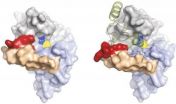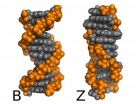(Press-News.org) This press release is available in German.
Using the world's most powerful X-ray free-electron laser, an international team of researchers, including scientists of the Max Planck Institute for Medical Research in Heidelberg, has obtained new insight into the structure of a medicinally important protein that may serve as a blueprint for the development of drugs to fight sleeping sickness. Science magazine have chosen the experimental study as one of the top ten scientific breakthroughs of the year.
Sleeping sickness is caused by the unicellular organism Trypanosoma brucei that is transmitted by tsetse flies. The disease kills about 30,000 people word-wide each year. The currently available drugs against the disease are of limited efficacy and can have severe side effects. Moreover, resistance against them is increasing. A promising drug target is the protein Cathepsin B whose enzymatic activity is vital for the parasite's survival. Inhibitors of Cathepsin B need to be highly specific against the trypanosomal variant because it resembles the human form. The featured work provides detailed insight into the structure of trypanosomal Cathepsin B in a natively inhibited form that might serve as a blueprint for the rational design of drugs. The biologically important form of the protein was obtained by a trick: instead of crystallizing the protein in plastic trays in the lab, it was crystallized in vivo in the cells that produced the protein. This approach provides natively modified proteins, but the crystals obtained are tiny.
The use of the X-ray free-electron laser (FEL) at Stanford was essential for the work. Protein structures are typically determined by exposing crystals of the protein to X-rays. Unfortunately, many of the most interesting proteins, such a membrane proteins, do not form crystals of sufficient size for analysis by conventional X-ray sources. Measurements using very tiny crystals have now become feasible thanks to the extreme intensity of FELs whose ultrashort pulse durations outrun most radiation damage effects. It is these properties that allowed structure analysis of the tiny in-vivo grown Cathepsin B crystals. Using a model system, the Heidelberg researchers and their international colleagues had previously validated this new approach using FELs as a tool for structure analysis, an important step in the method development that published in February 2012 in Science. The current featured research demonstrates for the first time FEL use to obtain new biologically important information. The international team shows in detail how the structures of typanosomal and human Cathepsin B differ and how the naturally occurring native inhibitor binds . This may provide new ideas for designing drugs against sleeping sickness.
The team included researchers from the Max Planck Institute for Medical Research, Heidelberg, the Center of Free-Electron Laser Science at Deutschen Elektronen-Synchrotron DESY, the Arizona State University, the Universities of Hamburg, Lübeck, Tübingen, Uppsala and Göteborg, the SLAC National Accelerator Center (USA), the Lawrence Livermore National Laboratory (USA) and the Max Planck Advanced Study Group at the Hamburg Center for Free-Electron Laser Science (CFEL).
INFORMATION:
Original publication
Lars Redecke et al.
Natively Inhibited Trypanosoma brucei Cathepsin B Structure Determined by Using an X-ray Laser
Science Express, November 29, 2012, DOI: 10.1126/science.1229663
Fighting sleeping sickness with X-ray lasers
Structure analysis of the trypanosomal protein Cathepsin B is among the scientific breakthroughs of 2012
2012-12-21
ELSE PRESS RELEASES FROM THIS DATE:
New calculations solve an old problem with DNA
2012-12-21
In a recent publication, researchers achieved new accuracy in the ability to measure energy differences between states of molecules, thus predicting which states will be observed.
It has been known since the seventies that excessive salt causes DNA to reverse its twist, from a right-handed spiral to a left-handed one. DNA in the Z form is treated by our natural repair enzymes as damaged, and is therefore usually deleted from the cell. Deletion of genetic material can lead to cancer or to other problems, so the B-Z transition is no mere curiosity. However such is the ...
Ups and downs of biodiversity after mass extinction
2012-12-21
The climate after the largest mass extinction so far 252 million years ago was cool, later very warm and then cool again. Thanks to the cooler temperatures, the diversity of marine fauna ballooned, as paleontologists from the University of Zurich have reconstructed. The warmer climate, coupled with a high CO2 level in the atmosphere, initially gave rise to new, short-lived species. In the longer term, however, this climate change had an adverse effect on biodiversi-ty and caused species to become extinct.
Until now, it was always assumed that it took flora and fauna ...
Strength training improves vascular function in young black men
2012-12-21
CHAMPAIGN, Ill. — Six weeks of weight training can significantly improve blood markers of cardiovascular health in young African-American men, researchers report in the Journal of Human Hypertension.
The researchers measured blood markers associated with inflammation, immune response or the remodeling of arteries that normally occur after tissue damage, infection or other types of stress. They found that levels of two of these markers dropped significantly in African-American men but not in Caucasian men after six weeks of resistance training.
"This suggests that resistance ...
Physicists take photonic topological insulators to the next level
2012-12-21
AUSTIN, Texas—Researchers at The University of Texas at Austin have designed a simulation that for the first time emulates key properties of electronic topological insulators.
Their simulation, which was described this week in Nature Materials, is part of a rapidly moving scientific race to understand and exploit the potential of topological insulators, which are a state of matter that was only discovered in the past decade. These insulators may enable dramatic advances in quantum computing and spintronics.
"The discovery of these materials, which are insulators in ...
Targeted gene silencing drugs are more than 500 times more effective with new delivery method
2012-12-21
New Rochelle, NY, December 20, 2012—Small interfering RNAs (siRNAs) are a potent new drug class that can silence a disease-causing gene, but delivering them to a target cell can be challenging. An innovative delivery approach that dramatically increases the efficacy of an siRNA drug targeted to the liver and has made it possible to test the drug in non-human primates is described in an article in Nucleic Acid Therapeutics, a peer-reviewed journal from Mary Ann Liebert, Inc. publishers (http://www.liebertpub.com). The article is available on the Nucleic Acid Therapeutics ...
Researchers discover genetic basis for eczema, new avenue to therapies
2012-12-21
CORVALLIS, Ore. – Researchers at Oregon State University today announced the discovery of an underlying genetic cause of atopic dermatitis, a type of eczema most common in infancy that also affects millions of adults around the world with dry, itchy and inflamed skin lesions.
The findings were just published in PLoS ONE, a professional journal, and may set the stage for new therapeutic approaches to this frustrating syndrome, which is difficult to treat and has no known cure. Eczema is also related to, and can sometimes cause asthma, a potentially deadly immune dysfunction.
Pharmaceutical ...
Extending steroid treatment does not benefit children with hard-to-treat kidney disease
2012-12-21
Highlights
Six months of steroid treatment in children with nephrotic syndrome did not reduce relapse rates or side effects compared with three months of treatment.
Because many children with nephrotic syndrome face frequent relapses, future research should focus on preventing relapses through new treatment strategies.
Nephrotic syndrome has an estimated incidence of two to seven cases per 100,000 children and a prevalence of nearly 16 cases per 100,000.
Washington, DC (December 20, 2012) — Extending steroid treatment for the most common form of kidney disease ...
New target for treating prediabetes in patients with kidney disease
2012-12-21
Highlights
Retention of certain compounds that are normally excreted by the kidneys may cause insulin resistance, or prediabetes, in kidney disease patients.
When mice with kidney disease were treated with a prebiotic that reduces blood levels of these compounds, insulin resistance and lipid abnormalities were prevented.
Washington, DC (December 20, 2012) —Insulin resistance, or prediabetes, in individuals with kidney disease may be caused by the progressive retention of certain compounds that are normally excreted by the kidneys in healthy individuals, ...
Science's Breakthrough of the Year: Discovery of the Higgs boson
2012-12-21
The observation of an elusive sub-atomic particle, known as the Higgs boson, has been heralded by the journal Science as the most important scientific discovery of 2012. This particle, which was first hypothesized more than 40 years ago, holds the key to explaining how other elementary particles (those that aren't made up of smaller particles), such as electrons and quarks, get their mass.
In addition to recognizing the detection of this particle as the 2012 Breakthrough of the Year, Science and its international nonprofit publisher, AAAS, have identified nine other ...
Wallace's century-old map of natural world updated
2012-12-21
Until today, Alfred Russell Wallace's century old map from 1876 has been the backbone for our understanding of global biodiversity. Thanks to advances in modern technology and data on more than 20,000 species, scientists from University of Copenhagen have now produced a next generation map depicting the organisation of life on Earth. Published online in Science Express today, the new map provides fundamental information regarding the diversity of life on our planet and is of major significance for future biodiversity research.
An essential question in understanding life ...
LAST 30 PRESS RELEASES:
Scalable and healable gradient textiles for multi‑scenario radiative cooling via bicomponent blow spinning
Research shows informed traders never let a good climate crisis go to waste
Intelligent XGBoost framework enhances asphalt pavement skid resistance assessment
Dual-function biomaterials for postoperative osteosarcoma: Tumor suppression and bone regeneration
New framework reveals where transport emissions concentrate in Singapore
NTP-enhanced lattice oxygen activation in Ce-Co catalysts for low-temperature soot combustion
Synergistic interface engineering in Cu-Zn-Ce catalysts for efficient CO2 hydrogenation to methanol
COVID-19 leaves a lasting mark on the human brain
Scientists use ultrasound to soften and treat cancer tumors without damaging healthy tissue
Community swimming program for Black youth boosts skills, sense of belonging, study finds
Specific depressive symptoms in midlife linked to increased dementia risk
An ‘illuminating’ design sheds light on cholesterol
Who is more likely to get long COVID?
Study showcases resilience and rapid growth of “living rocks”
Naval Research Lab diver earns Office of Naval Research 2025 Sailor of the Year
New Mayo-led study establishes practical definition for rapidly progressive dementia
Fossil fuel industry’s “climate false solutions” reinforce its power and aggravate environmental injustice
Researchers reveal bias in a widely used measure of algorithm performance
Alcohol causes cancer. A study from IOCB Prague confirms damage to DNA and shows how cells defend against it
Hidden viruses in wastewater treatment may shape public health risks, study finds
Unlock the power of nature: how biomass can transform climate mitigation
Biochar reshapes hidden soil microbes that capture carbon dioxide in farmland
Reducing saturated fat intake shows mortality benefit, but only in high-risk individuals
Manta rays create mobile ecosystems, study finds
Study: Mixed results in using lipoic acid to treat progressive multiple sclerosis
Norbert Holtkamp appointed director of Fermi National Accelerator Laboratory
New agentic AI platform accelerates advanced optics design
Biologists discover neurons use physical signals — not electricity — to stabilize communication
Researchers discover that a hormone can access the brain by hitchhiking
University of Oklahoma researcher awarded funding to pursue AI-powered material design
[Press-News.org] Fighting sleeping sickness with X-ray lasersStructure analysis of the trypanosomal protein Cathepsin B is among the scientific breakthroughs of 2012





